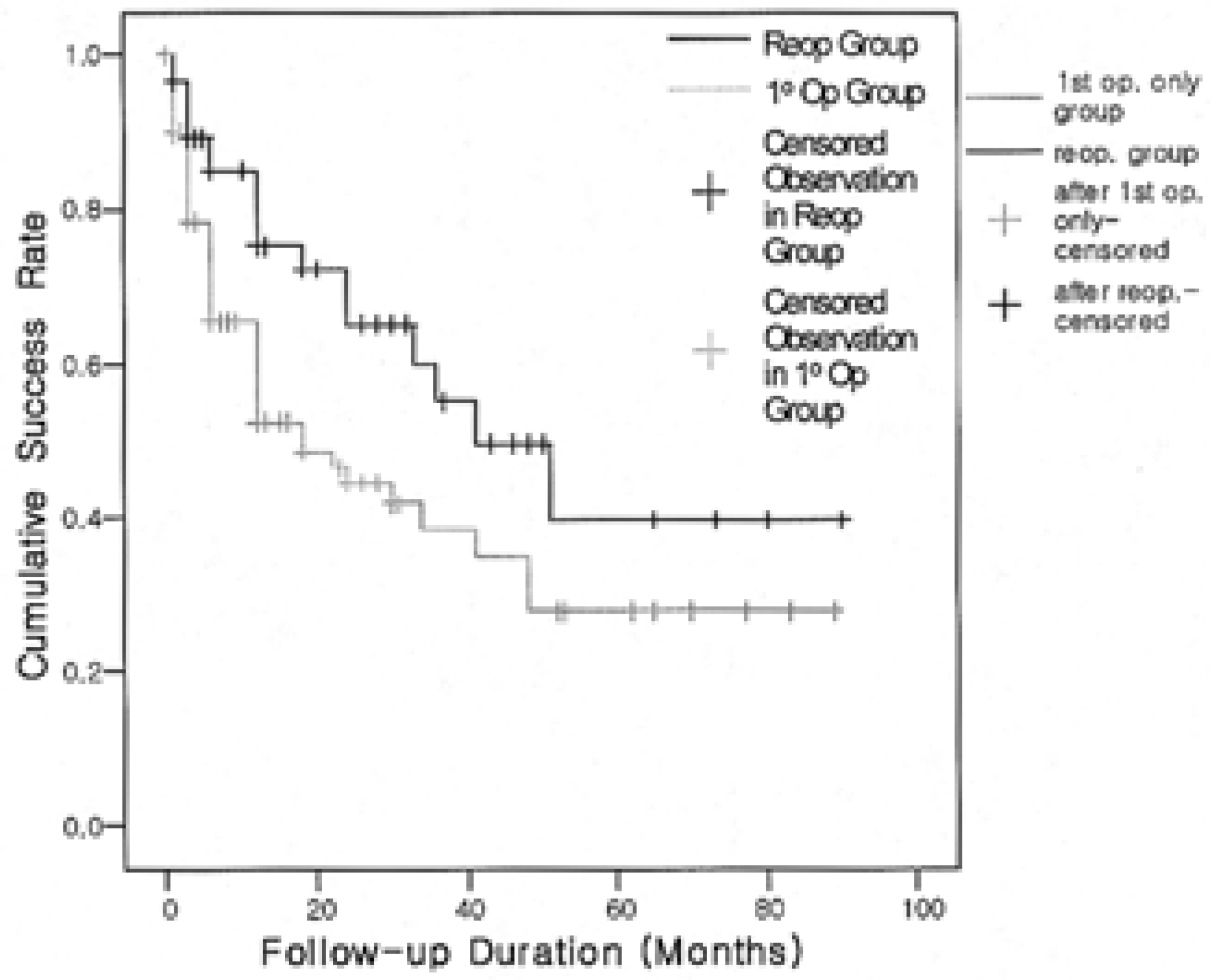Abstract
Purpose
To determine the clinical course of recurrent exotropia after a secondary operation for exotropia.
Methods
The surgical results in 58 patients who had undergone reoperation for recurrent exotropia (reoperation group) were retrospectively investigated and compared with those of 100 patients who had undergone primary strabismus surgery only (primary operation group) using survival analysis.
Results
In the reoperation group, recurrence occurred in 19 of the 58 patients (33%). Survival analysis revealed that the recurrence rates in the reoperation group were significantly lower than those in the primary operation group at the same follow-up period after the corresponding strabismus surgery (p=0.018). The distant esodeviation at the postoperative 1st week after reoperation was the only significant factor associated with the recurrence after reoperation (p=0.01).
REFERENCES
1. Friedmann L, Biedner B, David R, Sachs U. Screening for refractive errors, strabismus and other ocular anomalies from ages 6 months to 3 years. J Pediatr Ophthalmol Strabismus. 1977; 17:315–7.

3. Jenkins RH. Demographic geographic variations in the prevalence and management of exotropia. Am Orthop J. 1992; 42:82–7.
4. Friedmann Z, Neumann E, Hyams SW, Peleg B. Ophthalmic screening of 38000 children, age 1 to 2 1/2 years, in child welfare clinics. J Pediatr Ophthalmol Strabismus. 1980; 17:261–7.

5. Ing MR, Pang SWL. The racial distribution of strabismus. A statistical study. Hawaii Med J. 1974; 33:22–3.
6. Nam SH, Kim CH, Park SH, Shin HH. A vision screening in the preschool children. J Korean Ophthalmol Soc. 1990; 31:1089–95.
7. Yu YS, Kim SM, Kwon JY, et al. Preschool vision screening in Korea. J Korean Ophthalmol Soc. 1991; 32:1092–6.
8. Scott WE, Keech R, Marsh AJ. The postoperative results and stability of exodeviations. Arch Ophthalmol. 1981; 99:1814–8.

9. Hahm KH, Shin MC, Sohn MA. The change in deviation angle with time course after surgical correction of intermittent exotropia. J Korean Ophthalmol Soc. 2002; 42:2220–6.
10. Rabb EL, Parks MM. Recession of the lateral recti. Early and late postoperative alignments. Arch Ophthalmol. 1969; 82:203–8.
11. Pratt-Johnson JA, Barlow JM, Tilson G. Early surgery in intermittent exotropia. Am J Ophthalmol. 1977; 84:689–94.

12. Guyton DL. Strabismus surgery. Rice TA, Michels RG, Stark WJ, editors. Ophthalmic Surgery. 4th ed.St. Louis: Mosby;1984. p. 89.
13. Chang BL. Operative results in exotropia. J Korean Ophthalmol Soc. 1983; 37:729–84.
14. Kim MM, Cho ST. Longterm surgical results of intermittent exotropia. J Korean Ophthalmol Soc. 1994; 35:1321–6.
15. Ko KH, Min BM. Factors related to surgical results of intermittent exotropia. J Korean Ophthalmol Soc. 1996; 37:179–84.
16. Richard JM, Parks MM. Intermittent exotropia: Surgical results in different age groups. Ophthalmology. 1983; 90:1172–7.
17. Hardesty HH, Boynton JR, Keenan JP. Treatment of intermittent exotropia. Arch Ophthalmol. 1978; 96:268–74.

18. Beneish R, Flanders M. The role of stereopsis and early postoperative alignment in longterm results of intermittent exotropia. Can J Ophthalmol. 1994; 29:119–24.
19. Sohn HS, Chang BL. Management for reoperation in recurrent exotropia. J Korean Ophthalmol Soc. 1994; 35:580–4.
20. Kushner BJ, Fisher MR, Lucchese NJ, Morton GV. Factors influencing response to strabismus surgery. Arch Ophthalmol. 1993; 111:75–9.

21. Scott AB, Mash AJ, Jampolsky A. Quantitative guidelines for exotropia surgery. Invest Ophthalmol. 1975; 14:428–31.
22. Gordon YJ, Bachar E. Multiple regression analysis predictor models in exotropia surgery. Am J Ophthalmol. 1980; 90.

23. Kushner BJ, Lucchese NJ, Morton GV. The influence of axial length on the response to strabismus surgery. Arch Ophthalmol. 1989; 107:1616–8.

24. Graf M, Krzizok T, Kaufmann H. The influence of axial length on the effect of horizontal strabismus surgery. Binocular Vision. 1993; 8:233–40.
25. Maruo T, Kuboto N, Iwashige H, Kamiya Y. Longterm results after strabismus surgery. Graefes Arch Clin Exp Ophthalmol. 1988; 226:414–7.

26. McNeer KW. Observations on the surgical overcorrection of childhood intermittent exotropia. Am Orthop J. 1987; 37:135–50.

27. Ruttum MS. Initial versus subsequent postoperative motor alignment in intermittent exotropia. J Pediatr Ophthalmol Strabismus. 1997; 1:88–91.

28. Stoller SH, Simon JW, Lininger LL. Bilateral lateral rectus recession for exotropia: a survival analysis. J Pediatr Ophthalmol Strabismus. 1994; 31:89–92.

29. Keenan JM, Willshaw HE. The outcome of strabismus surgery in childhood exotropia. Eye. 1994; 8:632–7.

30. Gezer A, Sezen F, Nasri N, Gozum N. Factors influencing the outcome of strabismus surgery in patients with exotropia. J Pediatr Ophthalmol Strabismus. 2004; 8:56–60.

31. Ing MR, Nishimura J, Okino L. Outcome study of bilateral lateral rectus recession for intermittent exotropia in children. Ophthalmic Surg and Lasers. 1999; 30:110–7.

32. Lee JY, Choi DG. The clinical analysis of recurrence after surgical correction of intermittent exotropia. J Korean Ophthalmol Soc. 2002; 43:2220–6.
Fig. 1.
Comparison of survival curves between the primary operation group (1°Op Group) and the reoperation group (Reop Group) (p=0.018 by Log-rank test).

Table 1.
Comparisons of recurrence rates according to the follow-up (F/U) duration between the primary operation group (1°Op Group) and reoperation group (Reop Group)
| F/U duration (Months) | Recurrence rate (%) | |
|---|---|---|
| Reop group | 1°Op group | |
| 1 | 5 | 10 |
| 3 | 11 | 22 |
| 12 | 25 | 48 |
| 24 | 35 | 56 |
| 41 | 51 | 65 |
| 51 | 60 | 72 |
Table 2.
Comparisons between the success group (SG) and recurrence group (RG) in the reoperation group




 PDF
PDF ePub
ePub Citation
Citation Print
Print


 XML Download
XML Download